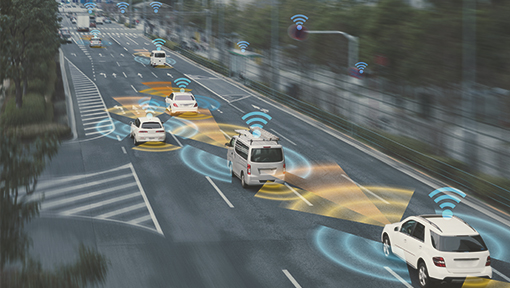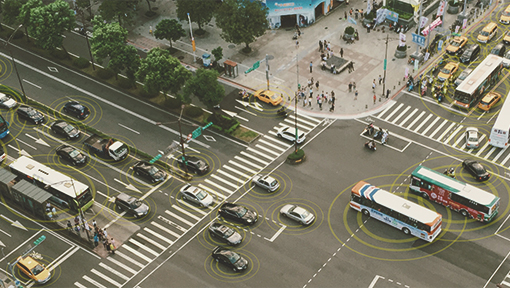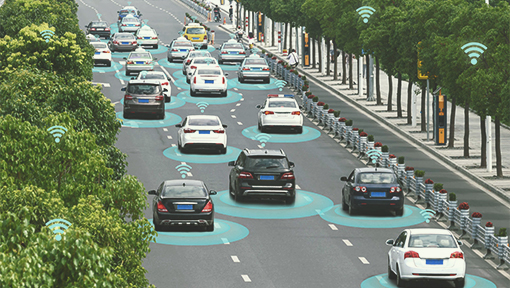Readiness Planning for Autonomous & Connected Vehicles
Autonomous vehicle (AV) and connected vehicle (CV) technologies promise to radically transform transportation. Traditional automakers and technology companies continue to test and roll out vehicles that are increasingly capable of “driving themselves” without the aid of a human operator. While specifics regarding AV and CV deployment remain uncertain, agencies can begin to identify steps that may be taken today to prepare their communities for the future arrival of these technologies. Given the breadth of AV and CV effects, readiness planning may cover a wide range of issues for public agencies, including — but not limited to — the topics described below.
Goal Setting & Outreach
Identify Goals & Objectives
Actions taken by public agencies should be informed by the community’s vision for its future: What are the key characteristics of that vision and how do AVs and CVs fit into them? What potential AV and CV outcomes does the community want to avoid, what existing characteristics should be protected, and what opportunities do these new vehicle technologies offer to help the community realize its desired vision? In short, goals should address how AVs will ideally be deployed in the community and how agencies can take control of achieving those outcomes.
Engage the Community & Stakeholders
It is vital to engage and educate the public and key stakeholders regarding AV and CV technology and related effects on the community. Effective engagement should establish lines of communication and a common foundation for constructive discourse on AVs and CVs. Successful public engagement will solicit comprehensive input on the long-term desires of the community and promote open dialogue to address key questions and concerns.
Acknowledge Possible Effects & Uncertainty
It is also critical for the public to both be aware of the effects of AV and CV technologies and to understand the uncertainty of their magnitude and timing. These effects may be both beneficial (improved safety, increased access to mobility, reduced driver stress) and adverse (increased traffic congestion, longer travel distances, and decreased transit ridership), and could vary in magnitude based on public acceptance of AV technology, the trips replaced by AVs (e.g., goods movement, deliveries, personal travel, etc.), and whether vehicles continue to be privately owned or if there is a substantial shift to a shared fleet model.
Regulatory Environment
Assess Existing Codes & Procedures
Public agencies should review their existing laws and codes that could be impacted by the deployment of AV and CV technology. Do current policies inadvertently hinder an agency’s ability to benefit from AV deployment or encourage outcomes that are counterproductive to the community’s goals?
Coordinate Across Agency Boundaries
As with conventional vehicle trips today, AVs will likely serve trips that travel between cities and have differing impacts in smaller versus larger cities and suburbs versus urban cores. Therefore, as part of the planning process, agencies should coordinate with their neighboring jurisdictions, transit agencies, and regional planning partners to identify common goals and lay the groundwork for regional or interregional cooperation to address AV and CV travel.
Engage with State & Federal Agencies
Federal and state agencies perform vital roles in regulating transportation and will continue to do so with new vehicle technology. It is critical for local and regional agencies to remain engaged in the regulatory process, given the substantial effects AVs and CVs may have on local roadways and the built environment. This may include monitoring state and federal regulatory proposals and collectively working with like-minded agencies and organizations to encourage a regulatory environment that does not hinder an agency’s ability to respond to AV and CV technology.
Planning Considerations
Use a Scenario-Planning Approach
Agencies should consider a scenario-planning approach that allows decision makers to see the potential range of outcomes that could occur from a range of possible situations. Scenarios may consider varying predictions on how industry, government, and consumer responses will affect AV and CV adoption. Despite the lack of historical information upon which to base planning assumptions, agencies still have many tools at their disposal to estimate the effects of various actions related to AVs and CVs.
Prioritize Resilient Infrastructure Investments
As agencies review their capital improvement and maintenance programs, it is wise to consider infrastructure investments that will have utility both with or without significant adoption of AV and CVs. Examples range from simple signing and striping upgrades that allow for better detection by AVs and CVs to large-scale investments, such as flexible rights-of-way, priority lane utilization, real-time data collection, and feedback to vehicles that improves safety and mobility.
Consider Policy Interventions
Absent any regulatory or major market changes, the introduction of AV and CV technologies is likely to facilitate vehicle travel, resulting in increased vehicle miles traveled (VMT), traffic congestion, and decreased transit ridership. Agencies can consider measures and policies that could address these impacts within the regulatory framework allowed by federal and state laws. A few examples include pricing strategies, transit enhancements, and shared-ride incentives or requirements.
Capitalize on the Abundance of New Data
AVs and CVs will generate a vast amount of data, some of which could be of huge value to public agencies if developed and managed properly. Applications include traffic control, road safety monitoring, and infrastructure management.
Integrate Emerging Mobility & Transportation Technologies
The confluence of AVs and CVs with other emerging technologies such as mobility service companies (e.g., Uber, Lyft, Zipcar, etc.), delivery services (e.g., Doordash, UberEats, etc.), and online shopping could profoundly affect the rate of AV adoption and future travel conditions. Therefore, how these other technologies are received by the public and regulated at the federal, state, and local levels will also affect future AV and CV travel.
Our AV Readiness Planning Services
AV Travel Demand Forecasting/Scenario Planning
How sensitive is your local or regional model to the likely effects of AVs?
Automated Transit Planning and First/Last Mile Connections
What is the potential of automated transit in communities, and how can AVs support effective mobility hubs and first/last mile connections?
AV Policy and Equity
What AV policies should cities be considering now to address the potential equity issues associated with widespread AV use?
VMT and Land Use Implications of AVs
How do AVs influence VMT and demand for certain land uses, and how should AVs be integrated into transportation and land use planning efforts?
AV Traffic Operations and Microsimulation Analysis
What effect will AVs have on congestion on local streets, freeways, and around important activity centers?
AV Street Design Guidance
To what extent can AVs support Complete Streets principles and Vision Zero goals, and how should streets be designed in response?
Learn more by contacting one of our industry experts.
Quick Links
© 2017 – 2024 Fehr & Peers. All rights reserved.




